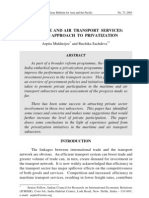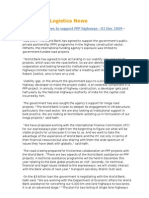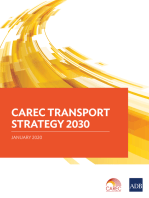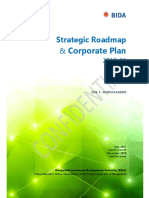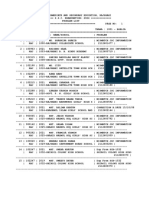Sector For Investment
Sector For Investment
Uploaded by
Shamsun Nahar KabirCopyright:
Available Formats
Sector For Investment
Sector For Investment
Uploaded by
Shamsun Nahar KabirOriginal Title
Copyright
Available Formats
Share this document
Did you find this document useful?
Is this content inappropriate?
Copyright:
Available Formats
Sector For Investment
Sector For Investment
Uploaded by
Shamsun Nahar KabirCopyright:
Available Formats
Sector for investment: Infrastructure development (transportation) Sector overviewThe transportation sector is fundamental to trade growth for Bangladesh.
Ensuring adequate transportation infrastructure is therefore increasingly important to the countrys economic welfare. The countrys economy needs to grow at a sustained 8 percent per year to achieve the first goal of the MDGs: that of halving the proportion of people living under a dollar a day by 2015. To achieve this growth, the transport sector will need to reduce costs and allocate resources among different modes of transport in a more balanced manner. Significant untapped opportunities for private-sector participation exist in all transport modes but particularly in seaports, inland water terminals, airports, and railway operations; opportunities for specific investments exist in limited-access roads and toll bridges. Greater private-sector participation could help finance improvements necessary to meet rising transport demand and redress the sectors low productivity, especially in port and railway operations. Roads and highwaysThe national road network encompasses more than 220,000 kilometers (km) with paved roads totaling more than 105,000 km. The Roads and Highways Department (RHD) under the Ministry of Communications and the Local Government and Engineering Department (LGED) under the Ministry of Local Government and Rural Development are the two primary government agencies responsible for planning, constructing, and maintaining roads in Bangladesh. RHD has, for the most part, carried out its part of the 1991 Road Master Plan. Construction and rehabilitation activities have concentrated on five strategic corridors, with investments made to construct bridges and ferries and to upgrade roads to international standards. Financing was provided by the Asian Development Bank (ADB), International Bank for Reconstruction and Development (IBRD), USAID (often working together with CARE and World Vision), as well as Japan and the United Kingdom. Railways-
Bangladesh Railways (BR) uses both meter gauge (1,000 mm) and broad gauge (1,676 mm) track. BR operates 2,768 route kilometers (km) of track with a fleet consisting of 270 locomotives,1,300 passenger carriages and 11,000 freight wagons (figure 8.1) Most of the freight wagons (7,900) are obsolete 20-foot four-wheelers. Approximately 80 percent of BRs wagons and coaches are in service. Private-sector participation (PSP) opportunities in BR include potential unitary concessioning of the whole of BR; selected concessioning of individual services or lines; increased contracting out of services; and joint venture operations. The successful fiber-optic telecommunications joint venture can be used as a guide to developing future private public partnerships with BR.
Ports and inland waterwaysBangladesh has only two gateway ports, the Chittagong Port Authority (CPA) and the Mongla Port Authority (MPA). In 2000 these two ports together handled about 20 million tonnes of cargo, of which 87 percent were imports. Chittagong, the larger of the two ports, handles more than 80 percent of total sea-borne traffic and 25 percent of container traffic, representing approximately 490,500 twenty-foot equivalent units, or TEUs. By 2017 forecasts project that this container traffic will increase by 300 percent, to an amount well in excess of the ports capacity. Bangladesh also has 3,600 km of navigable waterways in the dry season, and almost 6,000 km in the rainy season.The system consists of eleven major inland river ports that transport passengers as well as substantial cargoes (about 5.6 million tonnes). The Ministry of Shipping (MOS) is responsible for both the seaports and the inland waterways. The two seaports, Chittagong and Mongla, are operated through autonomous port authoritiesthe CPA and the MPAwith the chairmen being senior naval officers. Air transportationThe size of the air transportation system in Bangladesh is relatively small compared with air transportation systems in other similar-sized developing countries. Government-owned
Biman Bangladesh Airlines (or Biman Air) is the major carrier. The Ministry of Civil Aviation and Tourism, though the Civil Aviation Authority of Bangladesh (CAAB) and Biman Air has responsibility for all air space regulatory functions, airports, and related infrastructure.
Key Government Strategies
The Government of Bangladesh (GOB) in its second National Strategy for Accelerated Poverty Reduction (NSAPR II), covering the period from FY09-11, states that 'an efficient transportation network with adequate coverage synchronized with sustained service delivery is an essential input for development of the economy.' The GOB is also in the process of approving the Integrated Multi Modal Transport Policy (IMMTP) which aims to build a secure, dependable and uninterrupted transport network, addressing problems related to road, rail, inland water transport, including access to ports and airports. The IMMTP will help GOB in achieving a more rational and balanced investment across the different transport modes. In 2004, the GOB approved a National Land Transport Policy to improve the policy and institutional environment for roads and railways in the country. In 2000, a National Shipping Policy was approved to introduce reform and private sector participation in ports and inland waterways. In 2003, a draft Railway Corporate Authority Act was developed to corporatize Bangladesh Railways.
BANGLADESH : Transport Sector Key Statistics Particulars Length of Roads Main Roads Units Km. Km. As of 2007 270,565 20,735
Paved Roads Access to All-SeasonRoads Road Density - LAND
% %
30 39
km/1,000 sq. km.
2,079
Rail Track Length Total No. of Ports Turnaround Time Total No. of Airports International
Km.
2835 2
Days
3.10 10 3
Financing investmentSufficient private commercial financing is not available-primarily due to noninvestment grade rating for Bangladesh debt and the absence of creditworthy public utilities. Investors, therefore, seek additional security for mobilizing market-based funding and supplement it with other sources of long-term financing. The project will address this constraint by establishing a Private Sector Infrastructure Development Fund. The fund will provide long-term debt financing for privately-sponsored infrastructure. The availability of this type of financing will facilitate better risk-sharing between private sponsors and the government, and increase the likelihood that projects with a high economic priority are implemented. The fund will thus have a catalytic role in attracting other sources of commercial and institutional finance, such as from export credit agencies and multi- and bilateral institutions. Lack of a well-defined policy, legal and regulatory framework, and the inability of public agencies to develop and promote sound transactions for private participation further constrain private investment. The project provides technical assistance to address these constraints and to strengthen the government's ability to develop and market well-structured
project opportunities. Technical assistance will also be provided to bolster transaction development and facilitation, capacity building, institutional development, and for conducting feasibility studies. A key feature of this project is the assistance to the Government for establishing transparent, internationally competitive bidding processes for selecting private sector sponsors and awarding concessions. It is expected that the total investment in private sector projects will be nearly US$900 million. Nearly two-thirds of this funding will be from private sector, commercial, and institutional sources. Besides the US$235 million provided by this credit, additional financing will be forthcoming by the British Department for International Development (US$7.5 million) and the Canadian International Development Agency (US$3.5 million). The credit will be on standard IDA terms with a maturity of 40 years including a 10-year grace period At present the local financial markets are unable to contribute substantially to infrastructure financing except for smaller projects. Besides internal funds, private infrastructure projects have obtained some funding from banks, finance companies, and MFIs. Development agencies like ADB,World bank provide long term loans alongside countries like japan and Korea from which the construction companies are originated from. During the 1990s the World Banks lending for transport to Bangladesh was the largest sector investment operation in the country. Since 1990, the Bank has approved six transport projects totaling USD 1.08 billion. Some recent projects include: The Emergency 2007 Flood Restoration and Recovery Assistance Program: The 2007 Floods directly affected over 13 million people in 47 districts of Bangladesh, caused more than 1000 deaths, affected over 2 million acres of agricultural land, and damaged infrastructure, social and educational facilities and private assets. The World Bank is supporting a two part flood assistance strategy, budget support and restoration of infrastructure and livelihoods to help the country cope providing $70 million.
The Rural Transport Improvement Project 2003-2009, extended till 2011 with a credit amount of US$ 190 million, aims to provide rural communities with improved access to social
services and economic opportunities, and to enhance the capacity of relevant government institutions to better manage rural transport infrastructure in 21 districts of the country. The Bangladesh Railway Reform Programmatic Development Policy Credit was the first major Bank operation in the countrys railway sector. The objective is to improve the governance structure within which Bangladesh Railway operates addressing both governance relationship between the Government and Bangladesh Railway on the one hand, and corporate governance and management structure within the railways organization on the other. In 2007 the Bank prepared an Inland Water Transport (IWT) "IWT Strategy in Bangladesh" to provide an overview and assessment of Inland Water Transport in Bangladesh and to help the Government to define a strategy agreed with the stakeholders to bolster the sectors contribution to shared growth and poverty reduction. The Bank is continuing dialogue with the Govt. on various issues related to institutional strengthening of the Roads and Highways Department (RHD) and a Public Expenditure Tracking Survey of RHD is being carried out. Another proposed project, the Export Infrastructure Development Project, will help enhance the countrys trade competitiveness by assisting the rail sector through constructing a modern rail based Inland Container Depot at Dhirasram near Dhaka. It is envisaged that the project will be implemented on a Public-Private Partnership (PPP) basis. Construction of Padma Bridge is an important development agenda for the Government of Bangladesh (GOB). The proposed Bridge will be 6.8 Kilometer long, 25-meter wide with fourlane roadway and a railway track, gas pipeline and electricity power transmission line on it. Development partners will provide lending support for the project and it is expected that the WB will provide nearly US$ 1.2 billion with the Asian Development Bank (ADB) lending about US$ 615 million,Japan Internatinoal Cooperation Agency (JICA) lending US$ 300 million and the Islamic Development Bank lending US$ 140 million. In this regard the World Bank has already processed a $3 million Project Preparation Facility (PPF) to start the preparatory works and is the coordinating donor for this flagship project.
Major development partners in the Bangladesh transport sector are the World Bank, the Department for International Development of the United Kingdom (DFID), the Japan International Cooperation Agency (JICA), the Organization of the Petroleum Exporting Countries (OPEC) Fund for International Development, the Islamic Development Bank, and the Kuwait Fund for Arab Economic Development. Several bilateral agencies have also assisted the rural infrastructure sector. The development partners are united in supporting Bangladesh's National Land Transport Policy to ensure sustainable maintenance of roads and ensure that other sector governance issues are addressed. In subsectors where other development partners play a leading role, such as in inland water transport and telecommunication, ADB has taken a supportive role.
Opportunities: The government of Bangladesh (GOB) has begun to appreciate the viability of private investment in certain circumstances. For example the Bangladesh Inland Water Transport Authority (BIWTA) has invited private investors to develop a container terminal in Narayanganj. Operation and maintenance of the Jamuna River Bridge is in the hands of a private consortium Bangladesh Railway (BR) has encouraged private investment in passenger train operations. A british company named Port Evolution Management Company submitted a US$ 800 million plan for the development of Mongla port. The proposed 6.15-kilometre steel-truss Padma bridge will cost $2.9 billion which will be provided by The World Bank $1.20 billion, ADB $615 million, Japan government $300 million and the Islamic Development Bank $140 million for building the roadcum-railway bridge. These success stories have had a common, key feature. In each case, private-sector interests and resources were fitted with a project that has a revenue stream and a cost base that allows profitable operations.
Issues affecting investment: Attracting private-sector investment in transportation projects can be complicated by issues relating to: institutional inertiaThe strong hierarchical structure of transportation departments leads to senior management instability. Even the reform minded senior bureaucrates cannot make an impact because of small tenure and for the inefficiency and unwillingness of the lower-level managers. regulationDesigning a transparent and effective regulatory framework for long-term transportation concessions will be a challenging task.The longterm nature of the contracts, together with ambiguous distinctions between public and private risk and changing macroeconomic and political environments make transportation concessions especially difficult.
regional integrationAt present, Bangladesh prohibits the movement of foreign trucks and rail wagons on Bangladeshi territory. All foreign cargo is transshipped, at designated border stations, to Bangladeshi trucks or domestic rail wagons for transportation onward. Despite continued dialogue among concerned countries, very little progress has been made toward a mutually beneficial solution Asian highwayThe United Nations Economic and Social Commission for Asia and the Pacific (UNESCAP) is actively involved in promoting the expansion and development of the Asian Highway and Trans-Asian Railway as a part of an integrated sea, land,and air transportation
system to facilitate regional and international trade and tourism. The proposed railway and highway networks will cross Bangladesh en route to destinations in West Asia,Southeast Asia, and North Asia. Examples of other developing countries: IndiaThe government can well learn from the experience gathered by neighbouring India which has been operating a similar kind of fund since 2006. The Indian Infrastructural Fund Company Ltd. has been successfully providing long-term assistance to various viable infrastructure projects. Until March 2009, its track record was highly impressive. The IIFCL has been lending funds to infrastructure projects that are implemented by a public sector company or a private one selected under the public-private partnership (PPP) initiative or a private sector entity under certain conditions. The company had made investments worth Indian Rs 188 billion in 107 projects until March 2009. Having zero default-rate the company has turned out to be a profitable one. JapanThe Japanese government invested a great share of government expenditure in infrastructure sectors,especially for the transportation and energy sectors during 1911-38. Government expenditure to transportation and communication sectors including roads and ports is extremely big, it exceeds 60% of total expenditure. The growth of mining and manufacturing sector was rapid and the average growth rate of national income in the period of 1911-38 was 3.6%.
KoreaThe First Five-year Economic Development Plan was launched in 1962. Main objectives of the economic policy in this phase were income increment in agricultural sector, infrastructure development, and other social overhead capital development. A big proportion of government
expenditure was invested in the construction of infrastructure through this plan. The average annual growth rate of gross domestic investment to GDP was 19.9%, and the share of public sector of gross domestic investment in this phase was 38.1%. The share of expenditure for transportation and communication in economic services increased to 36.5% in 1971 from 21.4% in 1962. Annual average growth rate of GDP was 7.1%, and export grew at 27.1% during this phase.
You might also like
- Sydney Cross City - AnalysisDocument7 pagesSydney Cross City - Analysisac5453No ratings yet
- An Efficient Transportation System Is Essential To Facilitate Economic Growth in BangladeshDocument3 pagesAn Efficient Transportation System Is Essential To Facilitate Economic Growth in BangladeshMd Nazmus SakibNo ratings yet
- BUS 530 Term PaperDocument16 pagesBUS 530 Term PaperAnonymous iPNgVFLjKVNo ratings yet
- Role of PPP in Transportation SectorDocument26 pagesRole of PPP in Transportation SectorQuasarRNo ratings yet
- Report On Infrastructure: Economics AssignmentDocument5 pagesReport On Infrastructure: Economics AssignmentIshani ChaudhuriNo ratings yet
- Developments and Opportunities in Infrastructure - Indian ScenarioDocument11 pagesDevelopments and Opportunities in Infrastructure - Indian ScenarioAtique MohammedNo ratings yet
- Guidelines For Investment in Road Sector (As On 15 January 2013)Document47 pagesGuidelines For Investment in Road Sector (As On 15 January 2013)Sarkar RakeshNo ratings yet
- SCM Jury AssignmentDocument9 pagesSCM Jury AssignmentJyoti RawalNo ratings yet
- Transport and Communications: Table 13.1: Estimated Length of Roads in Provinces (KMS)Document23 pagesTransport and Communications: Table 13.1: Estimated Length of Roads in Provinces (KMS)Owais SabirNo ratings yet
- Devikas Assignment 1Document11 pagesDevikas Assignment 122082165No ratings yet
- INDIA InfrastructureDocument16 pagesINDIA InfrastructureKamal AssafNo ratings yet
- National HighwayDocument12 pagesNational Highwayanuj19iitNo ratings yet
- Performance of Major PortsDocument5 pagesPerformance of Major PortsrohityadavalldNo ratings yet
- Modes of Transport in IndiaDocument18 pagesModes of Transport in IndiaJinny SebastianNo ratings yet
- Cia 3 Public Economics HgygDocument10 pagesCia 3 Public Economics Hgygsovit agarwalNo ratings yet
- NHAI Report Part 1 OptDocument52 pagesNHAI Report Part 1 OptnavbizNo ratings yet
- Construction PDFDocument5 pagesConstruction PDFKabeyisi James OpponNo ratings yet
- Different Projects of Indian GovernmentDocument22 pagesDifferent Projects of Indian GovernmentkanikaNo ratings yet
- Rakesh Mohan Committee Report On Transport Development PolicyDocument13 pagesRakesh Mohan Committee Report On Transport Development Policyrajupat1230% (1)
- NHAIFinalDocument48 pagesNHAIFinalhimanshusabooNo ratings yet
- Transport Infrastructure in LogisticsDocument32 pagesTransport Infrastructure in LogisticsAkarshaNo ratings yet
- NhaiDocument53 pagesNhairmpklNo ratings yet
- Transportation Economics Project.Document28 pagesTransportation Economics Project.Aman Milwani100% (2)
- Chapter 11 enDocument27 pagesChapter 11 enS. M. Hasan ZidnyNo ratings yet
- Maritime and Air Transport Services: India'S Approach To PrivatizationDocument27 pagesMaritime and Air Transport Services: India'S Approach To PrivatizationSanchit SharmaNo ratings yet
- Infrastructure of India: Presented By:-Nisha Nair Rajeev JhaDocument18 pagesInfrastructure of India: Presented By:-Nisha Nair Rajeev JhaNichu@No ratings yet
- BharatMala Pariyojana (DrishtiIAS)Document5 pagesBharatMala Pariyojana (DrishtiIAS)alexiusz993No ratings yet
- Indias Maritime Sector (Revised)Document11 pagesIndias Maritime Sector (Revised)Shahbaz Ahmed KhanNo ratings yet
- Transport Infrastructure in IndiaDocument8 pagesTransport Infrastructure in IndiaSagardwip DeyNo ratings yet
- PIF File RevisedDocument13 pagesPIF File RevisedAUNISH MUKHERJEENo ratings yet
- SECTOR Roads & HighwaysDocument3 pagesSECTOR Roads & HighwaysArjun SrivastavNo ratings yet
- Bharat MalaDocument12 pagesBharat MalakarthickpadmanabanNo ratings yet
- Roads ArticlesDocument22 pagesRoads ArticlesSanthosh KumarNo ratings yet
- No. 13 C. OKOYE & EMEKA'S PAPER B5Document20 pagesNo. 13 C. OKOYE & EMEKA'S PAPER B5Emeka AgbasiNo ratings yet
- Bangkok, Thailand, Rapid Transit System Case Study (Transportation)Document8 pagesBangkok, Thailand, Rapid Transit System Case Study (Transportation)Rahul DhimanNo ratings yet
- Development of Indian Economy With Respect To P Hysical Infrastructure Based On Economic Survey and Eleventh Five Year PlansDocument18 pagesDevelopment of Indian Economy With Respect To P Hysical Infrastructure Based On Economic Survey and Eleventh Five Year Plansshalini0703No ratings yet
- Chapter 3 Overall Activities of Bangladesh RailwaysDocument11 pagesChapter 3 Overall Activities of Bangladesh RailwaysSanjida Akter LamiaNo ratings yet
- Bangladesh and Industrial SectorDocument12 pagesBangladesh and Industrial Sectorarian11No ratings yet
- Government Initiatives - EconomicsDocument12 pagesGovernment Initiatives - EconomicsParag DarwadeNo ratings yet
- Ethiopia - Wacha-Maji Road Upgrading Project - Appraisal Report 0011-0015Document5 pagesEthiopia - Wacha-Maji Road Upgrading Project - Appraisal Report 0011-0015SISAYNo ratings yet
- Transportation SectorDocument21 pagesTransportation SectorAshwin .RNo ratings yet
- Construction Sector Current Scenario and Emerging TrendsDocument8 pagesConstruction Sector Current Scenario and Emerging TrendsKumar AtrayNo ratings yet
- Turkmenistan: Asian Development Bank Member Fact SheetDocument4 pagesTurkmenistan: Asian Development Bank Member Fact SheetMáté Bence TóthNo ratings yet
- Union Budget 22-23.pngDocument5 pagesUnion Budget 22-23.pngRajat saxenaNo ratings yet
- Man Ag Ing For Ex Cel Lence in Pub Lic Trans Por Ta TionDocument10 pagesMan Ag Ing For Ex Cel Lence in Pub Lic Trans Por Ta TionDoruk CoşkunNo ratings yet
- Dedicated Freight Corridor On Indian RailwaysDocument16 pagesDedicated Freight Corridor On Indian RailwaysPriyank SrivastavNo ratings yet
- Role of Transportation in LogisticsDocument9 pagesRole of Transportation in LogisticsNilanjan MazumdarNo ratings yet
- Transport & Logistics News: World Bank Agrees To Support PPP Highways - 03 Dec 2009Document21 pagesTransport & Logistics News: World Bank Agrees To Support PPP Highways - 03 Dec 2009Annu GuptaNo ratings yet
- 01.construction Industry - Importance - Review - Present StatusDocument10 pages01.construction Industry - Importance - Review - Present Statuskmkn2k1No ratings yet
- 7 Blue Economy, BDDocument24 pages7 Blue Economy, BDsakibhasandu3846No ratings yet
- Several Govt. Schemes (Sem V - 2023-24)Document22 pagesSeveral Govt. Schemes (Sem V - 2023-24)Gouri BelgamwarNo ratings yet
- Report On Highway and MarketDocument20 pagesReport On Highway and MarketMayankVermaNo ratings yet
- 3.overview of NHAIDocument5 pages3.overview of NHAIBharat Reddy100% (1)
- GMS Transport Sector Strategy 2030: Toward a Seamless, Efficient, Reliable, and Sustainable GMS Transport SystemFrom EverandGMS Transport Sector Strategy 2030: Toward a Seamless, Efficient, Reliable, and Sustainable GMS Transport SystemNo ratings yet
- Cambodia Transport Sector Assessment, Strategy, and Road MapFrom EverandCambodia Transport Sector Assessment, Strategy, and Road MapNo ratings yet
- Unlocking the Potential of Railways: A Railway Strategy for CAREC, 2017-2030From EverandUnlocking the Potential of Railways: A Railway Strategy for CAREC, 2017-2030No ratings yet
- Pacific Transport Sector Assessment, Strategy, and Road Map 2021–2025From EverandPacific Transport Sector Assessment, Strategy, and Road Map 2021–2025No ratings yet
- Board of Intermediate and Secondary Education, Mymensingh: Class Six Non-Final Student List (Session 2024)Document1 pageBoard of Intermediate and Secondary Education, Mymensingh: Class Six Non-Final Student List (Session 2024)rahmannishad1997No ratings yet
- Apurba Kumar DasDocument4 pagesApurba Kumar Dasrafinee7No ratings yet
- News Letter 2021Document16 pagesNews Letter 2021tisuchiNo ratings yet
- An Assignment On Primitive Society & Social Structure of Tribal People in BangladeshDocument7 pagesAn Assignment On Primitive Society & Social Structure of Tribal People in BangladeshSalman AfridiNo ratings yet
- BSMMU Orthopaedic Surgery March 2022Document1 pageBSMMU Orthopaedic Surgery March 2022Md.Shafiul EzazNo ratings yet
- Fall of DhakaDocument5 pagesFall of DhakaKhalid SalmanNo ratings yet
- Abreviation 2 PDFDocument13 pagesAbreviation 2 PDFAhmed ShaanNo ratings yet
- Would Be Affiliated Customers. Category Name NGODocument219 pagesWould Be Affiliated Customers. Category Name NGOShankar Nag BenuNo ratings yet
- Journal 5 The Impact of Culture On Business Negotiation Styles A ComparativeDocument14 pagesJournal 5 The Impact of Culture On Business Negotiation Styles A ComparativeYew Sze HeoyNo ratings yet
- Bida SRCP 20181217 FDocument61 pagesBida SRCP 20181217 FRidwan Haque DolonNo ratings yet
- His 103 Final: Wahiduzzaman Shanto 1722307642Document3 pagesHis 103 Final: Wahiduzzaman Shanto 1722307642Mamun SailNo ratings yet
- Bangladesh Startup EcosystemDocument32 pagesBangladesh Startup EcosystemGolam RabbaniNo ratings yet
- Guerrilla Is A Bangladeshi Film Based On The Events of TheDocument5 pagesGuerrilla Is A Bangladeshi Film Based On The Events of TheS.M. YAMINUR RAHMANNo ratings yet
- Capital Market Development Program in BangladeshDocument75 pagesCapital Market Development Program in BangladeshIndependent Evaluation at Asian Development Bank100% (1)
- Fragmented Perspectives, Transiting Signs of Urbanity - Everyday Lifes Representations and Uses of Space in Dhaka Bangladesh - Elisa T. BertuzzoDocument261 pagesFragmented Perspectives, Transiting Signs of Urbanity - Everyday Lifes Representations and Uses of Space in Dhaka Bangladesh - Elisa T. BertuzzoAnu AnucubdNo ratings yet
- Education of The Descendants of Refugees in West Bengal: A Comparative Study Between First-Generation and Second-Generation DescendantsDocument6 pagesEducation of The Descendants of Refugees in West Bengal: A Comparative Study Between First-Generation and Second-Generation DescendantsIJAR JOURNALNo ratings yet
- A Bangladesh-China-India-Myanmar Economic CorridorDocument12 pagesA Bangladesh-China-India-Myanmar Economic Corridortomas arturo tejeda rodalNo ratings yet
- SWOT of BkashDocument1 pageSWOT of BkashDil Afroz FarzanaNo ratings yet
- Bangladeshi Courier Service Agent DatabaseDocument4 pagesBangladeshi Courier Service Agent DatabaseTarek Bin OmarNo ratings yet
- Bangladesh Security and Exchange Commission (BSEC)Document10 pagesBangladesh Security and Exchange Commission (BSEC)islamalmamun0246No ratings yet
- Service Report 10.05.2023Document12 pagesService Report 10.05.2023PCL PNINo ratings yet
- Film.h: March 03, 2020 To Whom This May Concern. Subject: Quotation For The CPDL AvDocument31 pagesFilm.h: March 03, 2020 To Whom This May Concern. Subject: Quotation For The CPDL AvM.M. ShahriaNo ratings yet
- Marketing Report On Yellow by BeximcoDocument36 pagesMarketing Report On Yellow by BeximcoAhamed Najeeb Rahman75% (4)
- Academic Trade and Higher Education BooksDocument151 pagesAcademic Trade and Higher Education BooksAbdul Jabbar QuraishiNo ratings yet
- Education System of BangladeshDocument5 pagesEducation System of BangladeshMashrur Rahman Arnab100% (1)
- Invitation For Tenders (IFT) (International)Document3 pagesInvitation For Tenders (IFT) (International)Tamanna ChakmaNo ratings yet
- SSC - 2024 Problem ListDocument105 pagesSSC - 2024 Problem Listmamahin124567No ratings yet
- Bengal Under The Muslim SultansDocument5 pagesBengal Under The Muslim SultansMehnaz MumuNo ratings yet
- A1.Current Trends and Issues in English Language Education in AsiaDocument34 pagesA1.Current Trends and Issues in English Language Education in AsiaPham Thu Ha50% (2)
- Cultural Centres in Dhaka - EditedDocument4 pagesCultural Centres in Dhaka - Editedfarzadbd01736619911No ratings yet
























